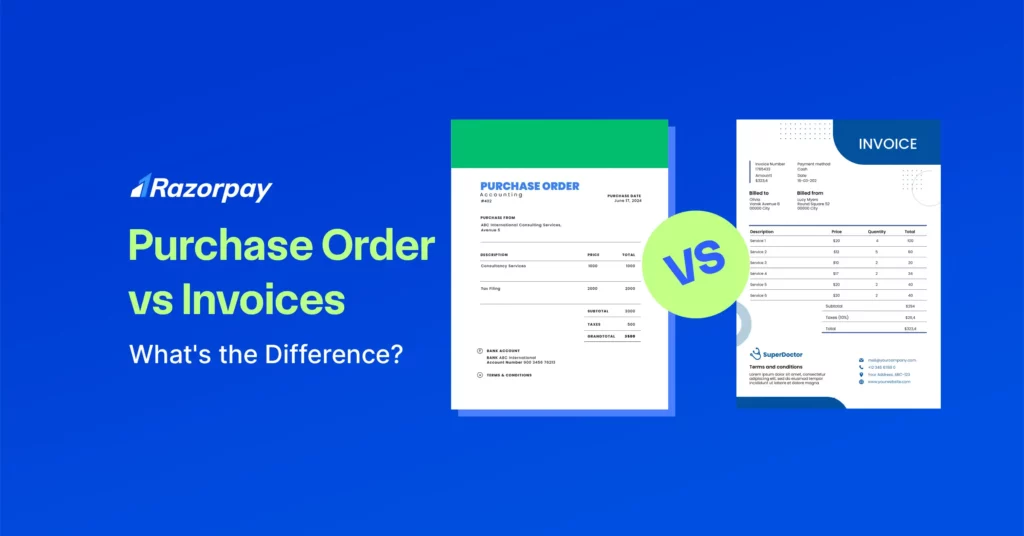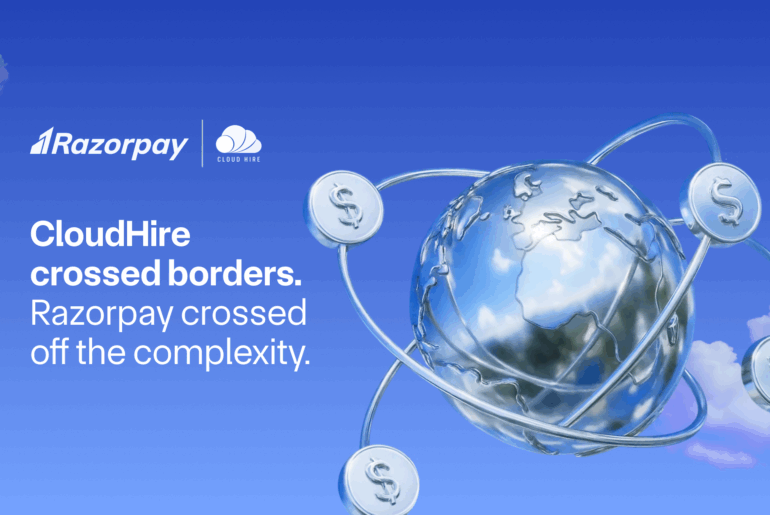If you have just started a new business, you may get confused between purchase orders and invoices. There are many similarities and variations between invoices from the vendor’s billing department and purchase orders from the buyer’s procurement department. Therefore, it is necessary to understand the difference between a purchase order and an invoice for the proper functioning of procurement and AP (accounts payable) departments.
Table of Contents
Difference Between Purchase Order and Invoice
The buyer issues a purchase order (PO) to specify the goods or services they want to acquire and the quantities. In contrast, an invoice is sent by the vendor to the buyer after fulfilling the purchase order, detailing the payment terms and options.
What Is a Purchase Order?
PO, or the purchase order, is a financial document issued by the buyer or a purchasing department to the seller or supplier. It contains details for the items needed to be purchased, such as quantity, kind of goods, and price. At the bottom of the PO, the seller has the option to sign. Once the seller signs the PO, it becomes a legally binding agreement for both parties.
After the supplier has met all the demands mentioned in the PO, he issues an invoice to the buyer. This invoice contains the details of the agreed-upon amount and payment options for the buyer. The supplier uses the same PO number to reference the invoice while demanding the money, which ultimately helps to make the payment process quick. A purchase order form is like a numbered contract that a buyer fills out to order things from a seller. It lists what is being ordered, where it should be sent, and how and when the buyer will pay for it. This form helps make sure everyone understands and agrees on what’s being bought and sold.
What Information Does Purchase Order Contain?
The PO includes the buyer’s name or company, expected delivery dates, a detailed description of the type and quantity of goods, price, shipping address, payment details, seller’s address, and a unique PO number. It also contains tax information and discounts, if applicable.
Additionally, the PO includes the phone numbers of both parties and outlines terms and conditions related to shipping, purchasing, and payment.
What Is an Invoice?
An invoice is like a bill that a supplier sends to a customer to request payment for goods bought, shipped or received. It shows what was bought, how much it costs, and when the payment is due. Invoices can have an “open” status for customer billing until they are paid, or a “paid” status if the customer completes the payment immediately in-store or online.
Related Read: Invoice vs Contract: What’s the Difference?
What Information Does Invoice Contain?
A legally bound invoice must contain every information listed below, that a buyer will need to make the payment:
- Sequential Invoice number
- PO number
- Order date
- Date of procurement or services rendered
- Invoice issuing date
- Contact details, including name and address of the buyer and seller
- Terms and conditions of payment
- Detailed description of goods or services purchased
- Price – per unit, including any discounts, if applicable
- Tax applicable
- The total amount to be paid by the buyer
- Payment due date
- Shipping cost, if any
- Any advance payment, if made
Sellers can also refer to the various templates or accounting software available online. It will help to ensure everything is included and nothing is missed.
Purchase Order Vs Purchase Invoices: Side-by-Side Comparison
| Features | Purchase Order | Invoice |
| Definition | A document from the buyer to the seller outlining the terms, quantity, and price expectations for the goods or services. | A document from the seller asking the buyer to pay for the goods or services rendered, along with the amounts owed. |
| Purpose | PO facilitates procurement by specifying what the buyer wants from the seller. | The invoice requests payment processing for goods or services rendered. |
| Issued by | It is issued by the buyer. | It is issued by the seller. |
| Issued to | It is issued to the seller. | It is issued to the buyer. |
| Timing | It is shared before goods and services are delivered. | It is shared after the PO once the goods and services are delivered. |
| Function | It shares the terms of the sales. | It confirms the sales of the goods or services. |
| Components | It includes order details, product description, price, quantity, delivery date, contact details, and unique PO number. | It contains information on the products delivered, description, price, quantity, payment terms, payment due date, and total amount due. |
| Legal status | PO becomes legal when the seller accepts it. | The invoice represents the buyer’s obligation to make the payment. |
| Role in procurement | PO initiates the process by specifying what the buyer wants from the seller. | The invoice completes the process by providing detailed delivery information and the total due amount. |
| Role in payment processing | It acts as a reference for payment and approves the expense. | It requests payment and gives the information needed to complete the transaction. |
| Example | A business issues a purchase order (PO) to a supplier specifying the quantity, cost, and terms of delivery for 100 pieces of a certain product. | The supplier provides the business with an invoice after delivering the 100 units, which includes information on the items delivered, the total amount owed, and payment instructions. |
Similarities Between Purchase Orders and Invoices
Just like there is difference between purchase order and purchase invoice, there are certain similarities as well. Both documents are finance-related documents informing about goods and services. They are essential in optimising spending and offer better visibility into the purchasing process. Both documents are legally bound and contain some basic information, like purchase details, vendor details, shipping information, and amount.
Examples and Scenarios of Purchase Orders and Invoices
Here is an example of a real-world scenario that will help in understanding what is difference between purchase order and invoice.
Let’s assume “A” owns a restaurant in Mumbai that he wants to remodel. After extensive discussions, he finalises “B” as the supplier. A, the buyer, and B, the supplier, agree on the furniture specifications, customisations, pricing, etc.
A’s purchasing department then raises a PO with B, detailing the required items, prices, quantities, delivery date, and a unique PO number.
B requests a change in the payment terms and the billing cycle from 60 to 30 days. A agrees and shares the updated PO, which B signs, making it legal. After it’s done, A follows up on the order status using the PO’s unique reference number, making it easy for B’s company to locate and provide the information.
During shipment, B includes the PO number on the invoice and shipping forms. The invoice contains details on products delivered along with the total amount due, payment terms, and mode of payment for invoice processing purposes. When the order arrives, A’s team uses the PO number for customs identification and payment, inventory updates, and accounting entries.
Once the order reaches the office, A’s team refer to the PO number to make an entry in their automated billing system for making the payment to B. This helps in updating the inventory and accounting files. A then makes the payment to B on the agreed date, and the invoice status is marked as paid.
Related Read: PO and Non-PO Invoices: Meaning, Differences and Examples
Why Do Companies Need Both Purchase Orders and Invoices?
To handle procurement effectively, a company needs both purchase orders and invoices. POs initiate and manage orders with suppliers, providing precise details about the required products or services, quantities, and delivery specifications. They also help purchasers keep track of orders and ensure contract terms are met.
Invoices are used to solicit payment for products or services rendered. It includes a thorough explanation of the products or services offered, their amount, cost, and terms of payment. They help the buyer verify payments and ensure accurate billing Additionally, they serve as legal documents in case of disputes. Both POs and invoices are crucial for preventing errors and miscommunications in the procurement process.
Conclusion
Purchase orders and invoices have different purposes, yet both are necessary for effective payment and procurement procedures. Before a transaction, POs clear things up and avoid misunderstandings, while invoices guarantee correct financial records and expedite payments. When combined, they improve any company’s financial management, responsibility, and communication.
Related Read: What is Invoice Reconciliation and How to Reconcile Invoices?
FAQs
1. Can a purchase order be modified after it is issued?
A purchase order, when in the pending stage, can be changed before it is issued. Once a purchase order has been issued, it cannot be changed; you must void it and submit a new one.
2. Can I cancel a purchase order?
Yes, a purchase order can be cancelled, but it all relies on the parameters that the buyer and the seller have agreed upon. It is necessary to review the contract frequently and get in touch with the seller for any cancellations as soon as possible.
3. When is a purchase order issued, and when is an invoice generated in a business transaction?
The purchase order (PO) is issued by the buyer before the supplier delivers goods or services. In contrast, invoices are generated by the supplier after the goods or services have been delivered.
4. What if I receive a product different from what’s on the purchase order?
If the goods you get differ from the one listed on the purchase order, get in touch with the supplier once to let them know about the difference and ask for a remedy, such as a return or replacement.
5. Are there legal implications associated with purchase orders and invoices?
Purchase orders and invoices have legal implications. Purchase orders are binding contracts, while invoices formally request payment. Failure to fulfil these documents can result in legal action for breach of contract or debt collection. Proper management of these documents is essential to avoid legal disputes.
6. How long should I keep invoices and PO?
There are no set guidelines on how long one should keep these documents with them. They can be kept for a few years or forever.
7. What role do purchase orders and invoices play in inventory management?
Purchase orders initiate procurement and provide a record of ordered items, quantities, and delivery details. Invoices document the completed transaction and payment terms. Together, they enable inventory tracking, cost management, and supplier relationship management.
8. How does the payment process differ between a purchase order and an invoice?
A PO is issued by the buyer and accepted by the seller and the Payment is not due until the seller issues an invoice after fulfilling the purchase order. Whereas the seller issues the invoice, and the payment has to be made by the buyer as per the agreement.


